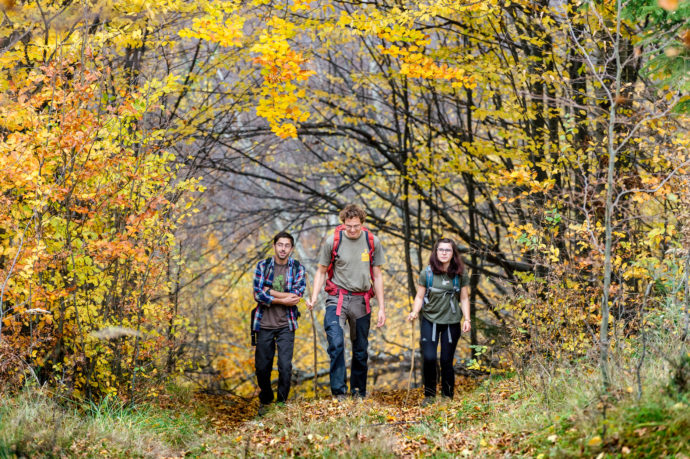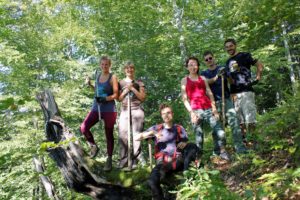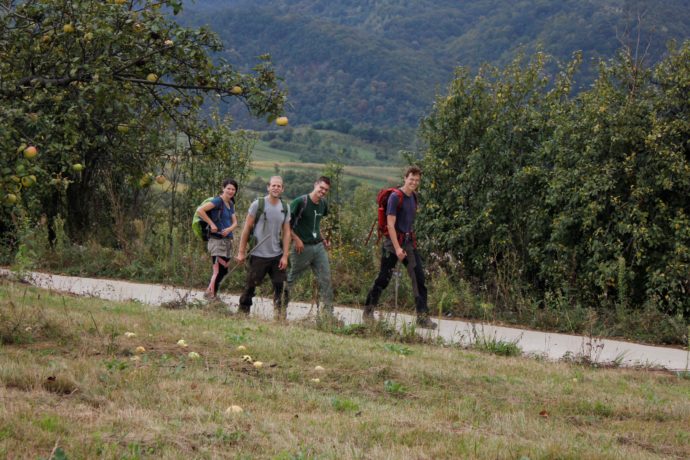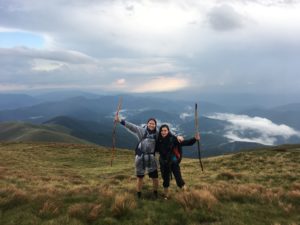Bison Hillock Taskforce provides invaluable support for Southern Carpathians rewilding
Taskforce activities, which in 2018 included data collection, website and app development, educational initiatives and community outreach, helped bolster the success of the area’s ongoing bison reintroduction programme.

The Bison Hillock Taskforce pushed the boundaries of conservation innovation and generated further support for the area’s bison reintroduction programme among local communities. BOGDAN COMANESCU
Bogdan Comanescu
The Taskforce is a research programme launched in 2016 with the support of the Swiss-Romanian Partnership (and now maintained annually through the WWF International Volunteering Programme). Since foundation, this has seen groups of young professionals from across Europe gather in the Southern Carpathians rewilding area in the summer and autumn to support local rewilding by performing a wide range of invaluable activities.

In 2018 the Bison Hillock Taskforce collected 589 camera trap videos, recording 12 different types of bison behaviour.
BIANCA ȘTEFANUȚ / LIFE BISON COMMUNICATION OFFICER
Last year’s Taskforce group – named the Bison Hillock Taskforce – pushed the boundaries of conservation innovation and generated further support for the area’s bison reintroduction programme among local communities. Before the group disbanded for 2018, the entire team made a visit to Bucharest to share their experience with colleagues in the Romanian capital. Three productive and informative presentations gave office-based personnel a real taste of the fieldwork carried out over the previous four months.
Here are a few numbers that give some idea of the scope and success of the Taskforce’s efforts in 2018.
- 68 direct observations of bison behaviour were made.
- 589 camera trap videos were collected, recording 12 different bison behaviours according to bison rewilding monitoring protocols.
- 86 hamlets were visited and evaluated, with the data used to create a preliminary risk index based on variables such as the number of haystacks and fruit trees present, the extent of protective fencing and previous debarking incidents involving bison.
- Six plots of land – each measuring 1000 square metres – were recorded as having been debarked by bison during the summer-autumn period.
- 127 debarked trees were recorded, as part of a study to measure the impact of bison on tree growth.
- Five data collection apps (Android and iOS) were developed.
- 25 bilingual articles on reintroduced bison and bison-related activities were written.
- 12 educational films were shown on “barn movie” nights that took place in four villages – Sat Bătrână, Armeniș, Sub Margine and Feneș – inspiring an average of 15 children per screening.

The Bison Hillock Taskforce used some of their time to explore Romania, spreading information about the reintroduced bison firsthand.
BIANCA ȘTEFANUȚ / LIFE BISON COMMUNICATION OFFICER
In addition to the above, a diagram illustrating the social structure of the reintroduced bison herd was created, based on direct observations of the animals made between September and November. Various contributions to the destination website were made, and a variety of video interviews were recorded, showcasing the joint efforts of the Taskforce, other volunteers, special guests and locals.

The Bison Hillock Taskforce used some of their time to explore Romania, and spread the information about the bison firsthand.
CĂTĂLIN GAVRILĂ
Despite the various challenges involved, all of the Taskforce members enjoyed their time spent in the Southern Carpathians rewilding area.
“Working in the field for so many days at a time, regardless of the type of weather, was undoubtedly tough,” says Romanian Astarte Maria Cirstea. “Yet being surrounded by such beautiful nature was ultimately hugely rewarding.”
“I found the project here very new and stimulating,” adds Italian Nicolo Capella. “It was great to build something from the beginning and every day discover something new. The reason I came here was to understand the meaning of fieldwork, and to see where the data I use and analyse actually comes from.”
One of the next steps will be to unify all the data collected by the Taskforce into a unified piece of software with the assistance of ESRI (GIS mapping software) specialists. This will then act as a tool to help predict bison-related behaviour, nutrition, distribution and other factors going forwards, supporting the success of the rewilding programme and thereby bringing further sustainable opportunities to the local community.
The work of the Bison Hillock Taskforce was officially wrapped up for 2018 on December 1 (Romania’s National Day), when a variety of community-focused courses and workshops were held in the rewilding area. The evening ended with a Taskforce presentation, a raffle, live music, good company and food.
Rewilding Europe would like to thank the Bison Hillock Taskforce for their hard work, dedication and creativity in support of the rewilding cause, and we look forward to more excellent results next year!